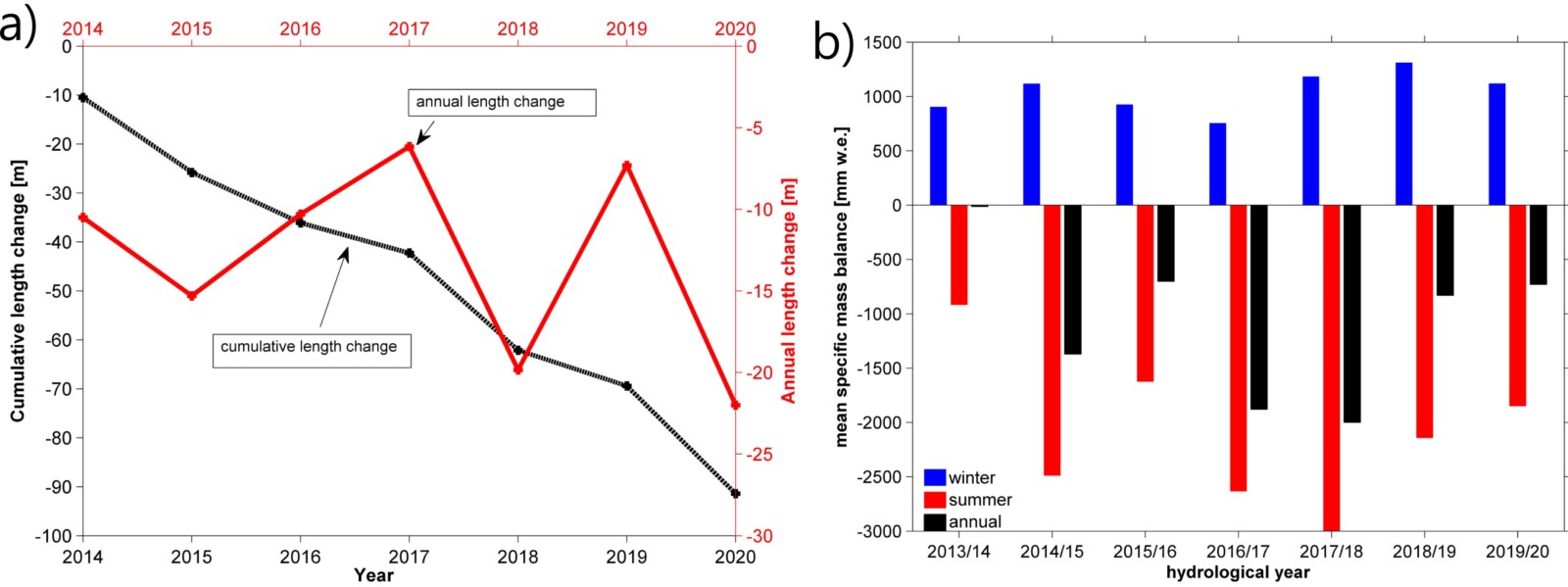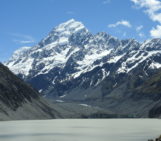
Figure 1. The Seekarlesferner in autumn 2013 (left image) and in autumn 2020 (right image). During those seven years the glacier lost 91 m in length and 7.5 m (water equivalent) in thickness. Radar measurements from autumn 2020 show an imminent separation of the glacier in the area of the rock step on the left and thus the transition from a small to a very small glacier (Credit: Markus Strudl).
The Alps were the first mountains to be studied from a glaciological point of view in the 19th century and they host some of the most studied glaciers of Earth. Some of them are found in the Central Alps and in particular, the Ötztal Alps. Just to cite the most known and largest glaciers in this Alpine sector, we can mention Hintereisferner or Vernagtferner. But in the Ötztal Alps you can also find many small glaciers which, as it often happens, do not get much attention because of the presence of some “big brothers”. This is a pity because from many perspectives small glaciers are not of secondary importance. If you want to know more about the small (and very small) glaciers of the Ötztal Alps you are in the right place!
What is a (very-) small glacier?
Defining small and very small glaciers is not an easy task. Various definitions exist. Moreover, different names or terms are used for such glaciers, like cirque glacier, micro glacier, glacieret, ice patch and Pyrenean glacier type. The most common definition is via artificial size classes, followed by qualitative approaches that take morphogenetic aspects into account. However, one should be aware that there is no consensus on how to define very small and small glaciers exactly. According to Fischer (2018), glaciers smaller than 0.5 km² are called very small glaciers. For glaciers smaller than 1 km² (and > 0.5 km²), the term small glaciers is used.
Why should we investigate such small glaciers?
Small and very small glaciers could seem of secondary importance, but this is not true at all! The meltwater provided by them is used for hydroelectric power production and to irrigate farmland in the dry inner-alpine regions. In addition, they can be related to natural hazards, like ice avalanches, glacier flood (outburst of lakes and water pockets) or glacier length changes. Small glaciers also influence the hydrological regime of alpine catchments and play a significant role in geomorphology (e.g. forming the landscape through the erosion of rocks and the sedimentation of glacial sediments). Despite this local importance of small and very small glaciers, glaciological measurement campaigns are limited to medium and large valley glaciers. In recent years, interest in these glaciers has increased because the smaller the glacier the more sensitive they are to climate change, responding quickly to climatic fluctuations. A typical feature of small glaciers is that their behavior is not only related to climate but also to local topography of the basin where they are found. This is because the smaller the glacier, the more important the role of exposure to solar radiation, of topographic shadows, of avalanches (related to the geometry of the walls above the glacier) and so on. Because of this, when you deal with a small glacier and study its behavior, it is always difficult to distinguish the effect of climate from the effect of local characteristics, it can be very confusing! This results in a limited understanding of the dynamics of very small glaciers, and their response to a changing climate. Furthermore, ice thickness estimates of small and very small glaciers are often unsatisfactory, as small glaciers experience very high variability in their snow coverage and melt due to the effects of local topography. Meaning each individual small glacier experiences very different snow melt and accumulation patterns. In the light of this, you will understand why we need to collect more empirical data of small and very small glaciers.
One more important thing! Because of the effect of climate change, it is expected that more and more glaciers will soon transition to small and very small glaciers. Subsequently, they are expected to become the dominant glacier type in many mountain ranges across Earth, making any research into them, even more important!
Glaciers on Kaunergrat
The Kaunergrat is a northern branch of the Ötztal Alps (a mountain range in Tyrol/Austria) and extends from the main Alpine ridge towards the Inn Valley in the north. About 3 % of its surface is glaciated, that is around 10 km² (in 2015). Thirty glaciers make up the glaciological assets of Kaunergrat, with an average area per single glacier of only 0.1 km². Furthermore, Kaunergrat is one of the wildest and most remote regions in the Ötztal Alps. If you like small or very small glaciers and if you enjoy working in remote regions, well, this is a sort of paradise!
Among these glaciers, only two exceed 1 km² and one of them is the glacier of interest to us. It is the Seekarlesferner (Figure 1) which has an area of 1.03 km², making it just above the threshold of being a very small glacier, but as a consequence of its ongoing disintegration, it will soon transition to this category. As I mentioned before, when glaciers become smaller and smaller, instead of being controlled by climate factors, they become more sensitive to local topographic features. With the monitoring of the Seekarlesferner we hope to enhance our understanding of the transition between climatically-controlled glaciers to topographically-controlled small glaciers. We want to better assess the timescale of such a transition and the future evolution of this kind of glaciers in a warming climate.
Initial findings of a short investigation period
Mass balance measurements (the overall gain and loss of ice in a glacier system across one year) of the Seekarlesferner were started in 2013 using the direct glaciological method. To do this we measure the amount of snow accumulated from autumn to spring on the glacier by digging snow pits and probing the snow depth. Then, during summer, we assess the amount of snow and ice that are lost through melting. Additionally, annual length measurements are carried out at Seekarlesferner and at the neighboring glaciers. The area changes are calculated from national aerial surveys that are frequently repeated. In individual years, these measurements are supplemented by special investigation such as Ground Penetrating Radar (GPR) – measurements to examine the thickness of ice, dating of moraines or geodetic mass balance investigations. We summarize the findings from these investigations in the two graphs below:

Figure 2. Cumulative (black line) and annual length change (red line) of Seekarlesferner (a) and mean specific mass balance from Seekarlesferner (b). In b), blue columns show the positive winter balance (snow accumulation), red columns the negative summer balance (melt) and black columns the annual integrated balance. (Data credit: ÖAV/Markus Strudl (a), Markus Strudl (b); Figure credit: Markus Strudl).
From the data in Figure 2 we can see that Seekarlesferner is currently experiencing an enhanced retreat of the glacier front and a persistent negative annual mass balance. This means that the glacier is melting at a rate which is significantly faster with respect to the accumulation of snow during cold months. Another important feature that is possible to appreciate in Figure 2 is the fact that the decline of the glacier is also highly variable between one year and another. These findings combine to support that Seekarlesferner is transitioning to a very small glacier, and we are observing enhanced debris cover as a result of increased rockfall caused by the disintegration of this glacier, another typical feature of small glaciers. All these factors support the hypothesis for the transition of Seekarlesferner to a very small glacier. The smaller the glacier becomes, the more variable and the more sensitive it is to changes in environmental conditions (like topography).

Figure 3. Incipient disintegration of the glacier area (left) and increasing debris cover on Seekarlesferner (right) Figure credit: Markus Strudl
What does this mean for the Kaunergrat?
Since 2015, the area of all glaciers on the Kaunergrat has decreased. The most significant changes occurred on comparatively “large” glaciers. Individual glaciers disintegrated into smaller sub-areas and we observed an enhanced debris cover on some glaciers. This means that the Kaunergrat will lose its small glaciers and thus also the important services mentioned at the beginning of this post. We also observed that the smallest glaciers surrounded by steep walls appear to be more controlled by topography than climate, perhaps meaning some of the small glaciers will survive a little longer than expected. Small glaciers, small but tenacious!

Figure 4. Panorama from Schweikertferner in autumn 2016. The tributary glacier in the foreground (left side) remained almost stationary since 2018. This can be explained by the accumulation of snow due to avalanches (topographical control). In contrast, the main glacier in the background is more subjected to climatic control and is thus persistently loosing mass and shrinking (Figure Credit: Markus Strudl).
Edited by Emma Pearce and Giovanni Baccolo
 Markus Strudl holds an MSc in Atmospheric Sciences at the University of Innsbruck and works today in the Photogrammetric department at Vermessung AVT in Imst. He started mass balance monitoring at Seekarlesferner in 2013 on a private basis. In addition, he carries out the measurement of glacier length changes on behalf of the Austrian Alpine Club. His main areas of interest are small and very small glaciers and their response to a changing climate. Contact Email: markus.strudl@gmail.com
Markus Strudl holds an MSc in Atmospheric Sciences at the University of Innsbruck and works today in the Photogrammetric department at Vermessung AVT in Imst. He started mass balance monitoring at Seekarlesferner in 2013 on a private basis. In addition, he carries out the measurement of glacier length changes on behalf of the Austrian Alpine Club. His main areas of interest are small and very small glaciers and their response to a changing climate. Contact Email: markus.strudl@gmail.com




